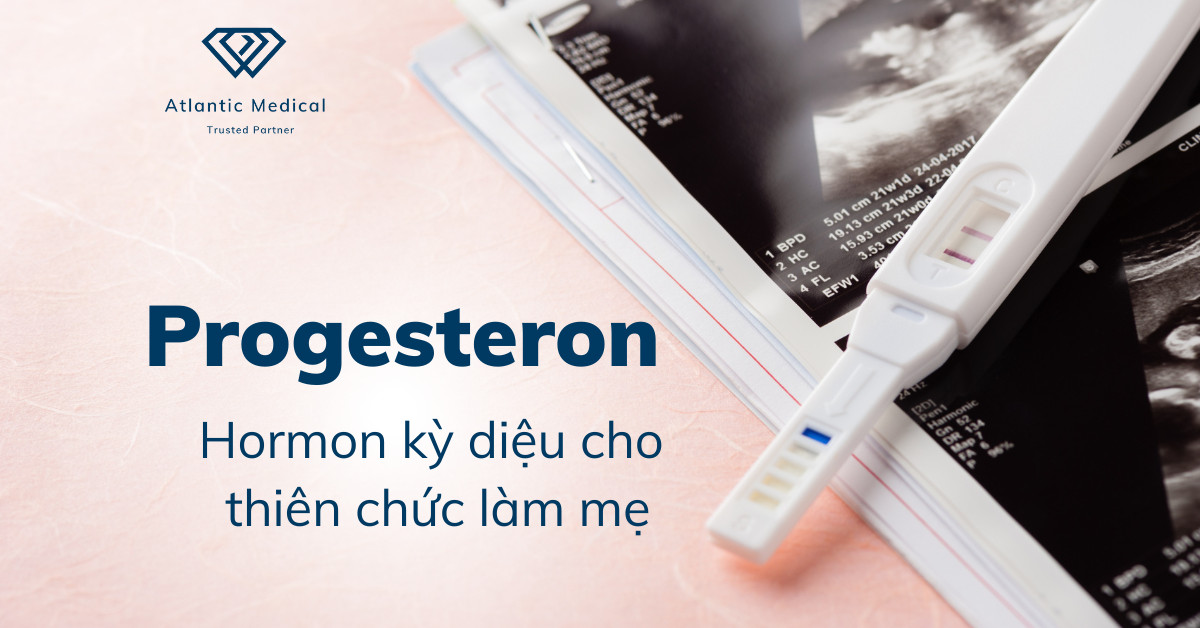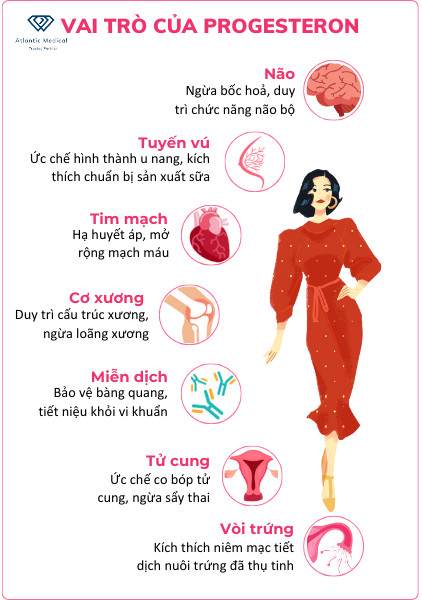
Progesterone and estrogen are two hormones that always go hand in hand and govern many specific metabolic and developmental processes of the female body, especially the menstrual cycle and pregnancy. So people have questions about what progesterone is, what effects it has on the body and what happens if the body lacks or has too much progesterone... Below, let's learn to answer the above questions.
Progesterone is an important steroid hormone in the body, especially for women. It is mainly produced by the ovaries, adrenal glands and placenta in pregnant women. Progesterone plays an important role in maintaining pregnancy, regulating women's menstrual cycle and many other physiological metabolism processes.
Progesterone is also a female sex hormone secreted mainly from the corpus luteum in the second half of the menstrual cycle. In the first half of the ovarian follicles and adrenal glands, only a very small amount of progesterone is secreted.
For pregnant women, progesterone is produced by the placenta and participates in the development of the fetus.
However, men also have a small amount of progesterone produced in the adrenal cortex. Progesterone in men is effective in sperm production.
Progesterone is one of the typical female sex hormones. It regulates the menstrual cycle and prepares for pregnancy and childbirth.
Progesterone affects the uterine lining and changes the volume of vaginal fluid.
From the beginning of the menstrual cycle, the ovulation phase, progesterone levels remain low. When mid-cycle reaches its peak, LH levels peak, the egg will be released, and the remaining egg will form the corpus luteum.
In the luteal phase, progesterone increases rapidly in concentration to prepare the uterus for fertilization and embryo implantation by stimulating new glands and blood vessels to develop in the mother's uterus.
But if the egg is not fertilized, the corpus luteum will break down, and progesterone levels will decrease sharply. This deterioration will cause the endometrium to break down and peel off, causing a new start of the menstrual cycle.

If the egg is fertilized, the corpus luteum is not broken down and continues to produce progesterone. At this time, progesterone will have the following effects:
On the uterus: Changes the uterine lining, creating conditions for the fertilized egg to implant; Inhibits the contractility of the uterus, preventing miscarriage.
On the fallopian tubes: Stimulates the fallopian tube mucosa to secrete fluid containing nutrients to nourish the fertilized egg into the uterus.
Mammary gland: Helps reduce breast tenderness and inhibit cyst formation. At the same time, progesterone also stimulates the cells in the mammary glands to proliferate, enlarge, and prepare to produce milk during pregnancy.
Cardiovascular system: Lowers blood pressure and relaxes smooth muscle cells, expands blood vessels, regulates blood clotting
Immune system: enhances the activity of the immune system, helping the body fight against harmful external agents such as bacteria...
From there, maintaining the pregnancy process thickens the uterine lining and prevents uterine contractions, helping to keep the fetus in the uterus.
A large amount of progesterone and estrogen are produced to stimulate mammary tissues and glands to proliferate and enlarge, preparing them for lactation after the baby is born.
Progesterone levels can be measured through a quantitative progesterone test. The results of measuring progesterone in the blood can partly indicate reproductive health and diagnose some diseases.
Progesterone levels are measured in nanograms per milliliter (ng/ml). Below are normal women's progesterone levels during the cycle and during pregnancy:
| Stage | Progesterone concentration (ng/mL) |
| Menopause, early menstrual cycle, men | ≤ 1 |
| On the day of ovulation | 5 -12 |
| After ovulation | 1.8–24 |
| First trimester (first 3 months of pregnancy) | 15-60 |
| Second trimester (second trimester of pregnancy) | 25.6-89.4 |
| Third trimester (last 3 months of pregnancy) | 48.4-42.5 |
However, progesterone levels fluctuate a lot not only according to the cycle but also during the day. Therefore, depending on each specific case, the doctor evaluates whether the progesterone level is within the normal range or not.
Abnormal progesterone levels
The production and regulation of progesterone is governed by a smoothly functioning system – the Hypothalamic-Pituitary-Ovarian system. But under harmful factors, the progesterone secretion regulatory system is dysfunctional. Progesterone levels have unusual fluctuations, which can also be the cause or manifestation of worrying disorders:
| Progesterone levels decrease | Progesterone levels increase |
|
Congenital adrenal dysplasia |
However, when progesterone levels are less than normal, there is no alternating change in concentration. The most obvious symptom is that it will lead to irregular or prolonged menstrual cycles.
Progesterone deficiency in women preparing for and during pregnancy will cause the following risks: poor fetal development, easy miscarriage, miscarriage... Underdeveloped mammary glands reduce milk supply to the baby, easily leading to milk deficiency and loss of milk after birth.
Premenopause and menopause: ovarian function declines, hormones produced by the ovaries also gradually decrease in quantity and concentration. Then progesterone will drop low and even reach '0' at menopause. It also causes a series of symptoms: weight gain, hair loss, decreased desire…
Therefore, tracking the menstrual cycle is very important in monitoring a woman's reproductive health. Abnormal changes in progesterone can occur in various conditions and cause many negative effects on women's health.
According to studies, after the age of 30, female hormones gradually decrease over time, leading to abnormalities in progesterone levels. The cause is that the ovaries enter a period of 'weakness', do not respond to stimuli to produce sex hormones, and cannot send signals to the control center to 'ask for help'. Therefore, to balance female hormones, the only way is to supplement female hormones from the outside, thereby making the ovaries healthier and producing more hormones, causing the body to gradually rebalance.
However, currently supplementing female sex hormones has limitations: in severe cases, it increases the risk of breast cancer and uterine cancer; mild, endocrine imbalance, high blood pressure... And the use of female sex hormones requires a doctor's prescription.
Therefore, the solution to safely supplement hormones is to use natural products. This is a solution to help improve hormonal disorders safely, effectively and comprehensively. From there, it helps the ovaries become 'healthier' and solves problems with abnormal female hormones.

In addition, a healthy lifestyle is extremely necessary for hormonal balance.
In summary, progesterone is an important hormone for pregnancy and the menstrual cycle in women. It is produced mainly by the ovaries and uterine glands, and regulates many processes in the body. Let's learn about each hormone in the body and the stages that women must go through to understand and love themselves better. Watch now.

Business Registration Certificate No. 0109881571 issued by Hanoi Department of Planning and Investment on January 10, 2022
© 2023 Copyright by Atlantic Medical All rights reserved.